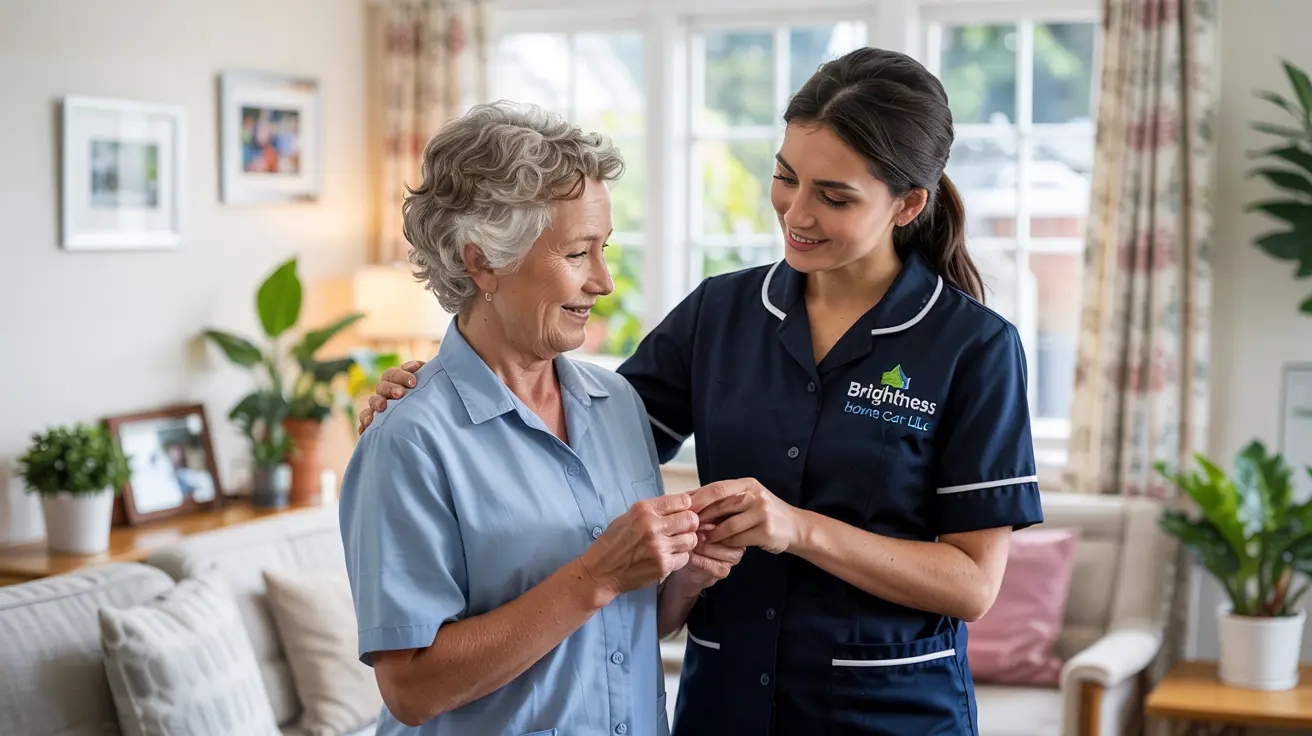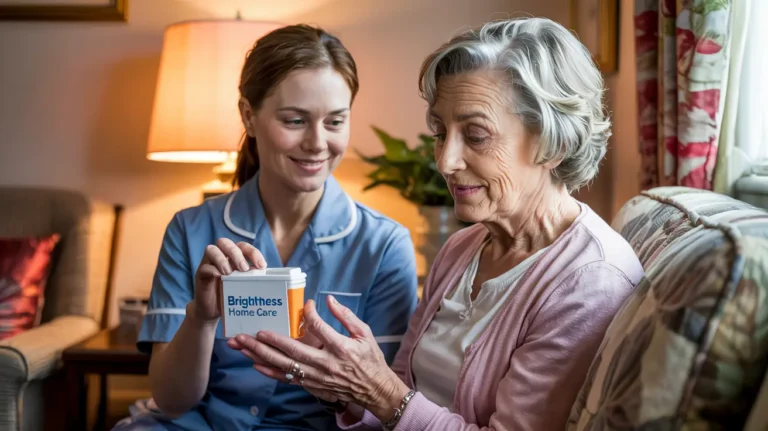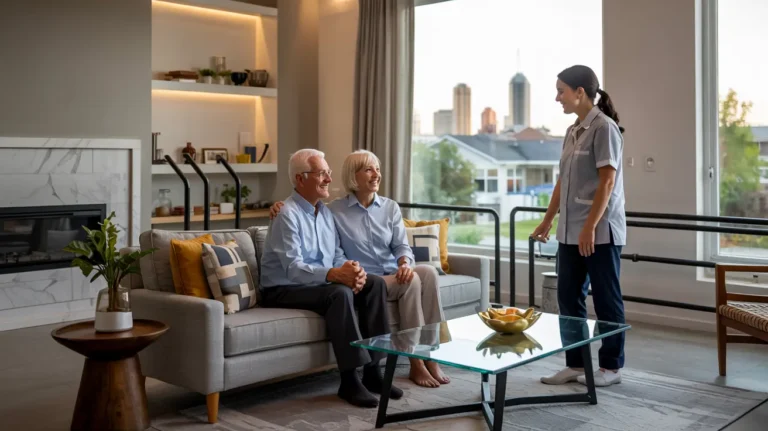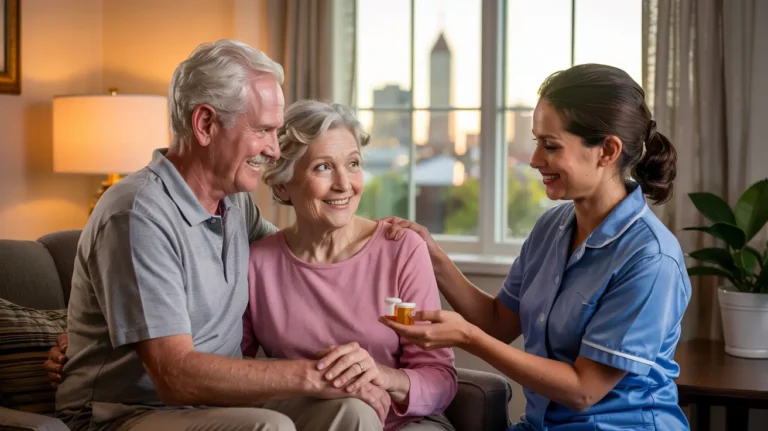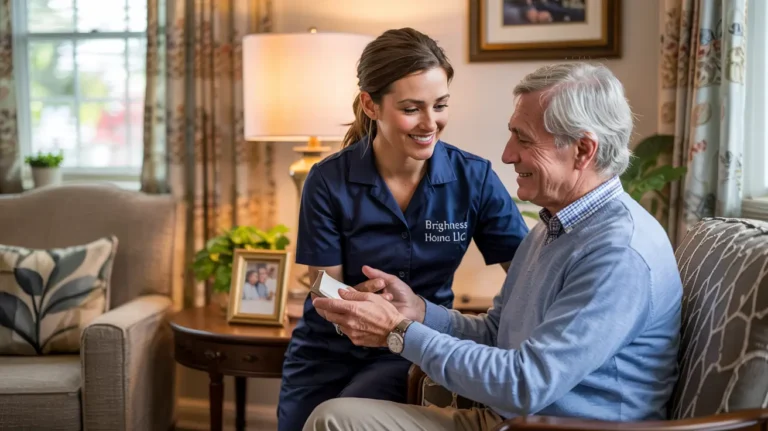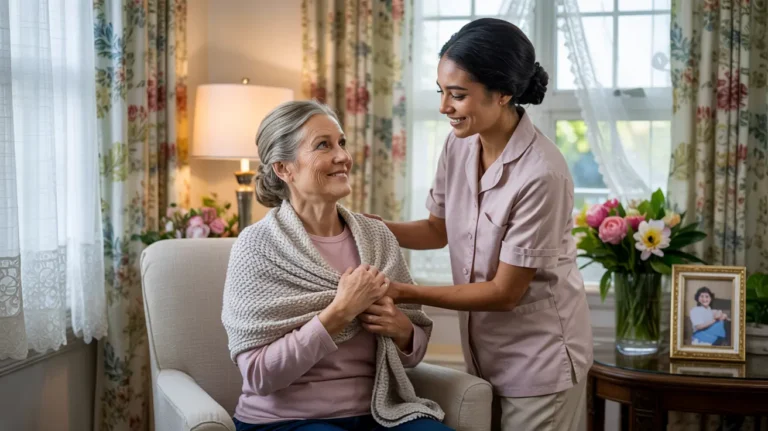Understanding Independent Living vs Daily Assistance Options in Indianapolis
Did you know that Indianapolis has seen a 15% increase in its senior population over the past decade? That’s a whole lot of folks facing tough decisions about their living situations! I’ve been helping families navigate these choices for years, and let me tell ya, understanding the difference between independent living and daily assistance isn’t always straightforward.
When my own mom started needing help around the house, I was completely overwhelmed by all the options. Should she stay at home with some help? Move to a retirement community? Get full-time care? The choices seemed endless and honestly, kinda confusing.
That’s where services like Brightness Home Care LLC come into play. Located right here in Indianapolis at 4911 West 38th Street, they’re changing how we think about care options. I wish I’d known about them when making decisions for my mom!
In this article, I’m gonna break down everything you need to know about independent living versus daily assistance options in Indianapolis. We’ll look at what each option really means, the costs involved, how to decide what’s right for your situation, and how places like Brightness Home Care can help you maintain that delicate balance between independence and necessary support. Trust me, I’ve been there, and having the right information makes all the difference!
What Defines Independent Living for Seniors in Indianapolis
Independent living is exactly what it sounds like – living arrangements where seniors maintain their autonomy while having access to amenities and sometimes light support services. I remember touring some of these communities with my aunt last year, and boy, they’ve come a long way from the “old folks homes” of yesterday!
Independent living typically refers to housing designed specifically for older adults who can still live on their own without daily medical assistance. These might be apartment complexes, condos, or even single-family home communities restricted to people typically over 55. The big difference from regular housing? They usually offer amenities tailored to seniors like transportation services, community activities, and sometimes even restaurant-style dining facilities.
Who benefits most from these setups? Generally, it’s active seniors who are still pretty self-sufficient but might appreciate the convenience and social aspects. My neighbor Jim moved into an independent living community after his wife passed, and he says the best part isn’t the nice apartment – it’s having buddies to play cards with every afternoon!
Around Indianapolis, you’ll find a bunch of different independent living options. There are luxury communities like The Barrington of Carmel with all the bells and whistles (swimming pools, fitness centers, the works!), and more affordable options scattered throughout the metro area. Some are standalone independent living, while others offer a “continuum of care” where you can move to more assisted options within the same community if needed.
How do you know if independent living might be right for your loved one? I always tell people to look for these signs: Are they generally healthy but maybe feeling isolated? Do they struggle with home maintenance but not personal care? Are they looking to downsize? Do they want more social opportunities? If you’re nodding your head, independent living could be worth exploring.
Now for the part nobody likes talking about – money. Independent living costs can vary wildly in Indianapolis. You’re typically looking at monthly fees ranging from $1,500 for basic apartments to upwards of $6,000 for luxury communities. What trips people up (like it did me!) is that many have entrance fees too, which can be substantial. The thing is, most independent living isn’t covered by Medicare or insurance – it’s considered housing, not healthcare.
I made the mistake of not fully understanding the financial structure when helping my aunt move. We didn’t realize her rent would increase by 3% annually, regardless of her fixed income! Make sure you read the fine print and understand exactly what’s included in the base price versus what costs extra.
Most folks in independent living still manage their own medications, drive themselves around, and handle their own housekeeping. They’re basically living like they would in any apartment or home, just with some added perks and amenities designed for seniors. The best independent living communities foster a sense of community while respecting residents’ privacy and independence – it’s a delicate balance!
When touring places, pay attention to the social calendar. A robust schedule of activities usually indicates a well-run community. My aunt’s place organizes everything from wine tastings to volunteer opportunities, and she’s busier now than she was before retirement!
One last thing about independent living – it can be a great preventative measure against isolation, which we know can lead to depression and cognitive decline in seniors. For many, the social aspect becomes the most valuable part of the experience. I’ve seen formerly withdrawn seniors absolutely blossom in these communities once they find their people. It’s pretty amazing what a difference that can make!
Understanding Daily Assistance Services in Indianapolis
Daily assistance is a whole different ballgame, and one I got crash-course educated on when my dad started showing signs of early dementia. Daily assistance services essentially help people with the activities of daily living (ADLs) that most of us take for granted – things like bathing, dressing, meal prep, medication management, and mobility help.
Unlike independent living, which focuses on housing, daily assistance is all about the services. These can be provided either in someone’s home (like what Brightness Home Care LLC specializes in) or in residential facilities like assisted living communities. I gotta tell ya, navigating this world was overwhelming at first – there are so many options and levels of care!
Daily assistance typically includes personal care services like help with bathing and dressing, medication reminders or management, meal preparation, light housekeeping, transportation to appointments, and companionship. The beauty of services like those offered by Brightness Home Care is that they’re completely customizable – you only pay for what you need. When Dad first started needing help, it was just medication reminders and transportation, but we were able to scale up as his needs changed.
So when does daily assistance become necessary? This is a tough one, and I’ve had to have this conversation with many families. The signs aren’t always obvious. Watch for things like declining personal hygiene, missed medications, weight loss from not eating properly, inability to keep up with housekeeping, or increased falls. In Dad’s case, it was finding expired food in his fridge and noticing he was wearing the same clothes for days that clued us in.
Companies like Brightness Home Care LLC work by sending trained caregivers to the person’s home on a schedule that works for their needs – whether that’s a few hours a day, overnight care, or even 24/7 support. After an initial assessment, they’ll create a care plan specific to what your loved one needs. What surprised me was how flexible the scheduling could be! When Dad had a doctor’s appointment, we could adjust the caregiver’s hours to make sure he had transportation and support.
The benefits of professional daily assistance are huge, especially for families like mine that were stretched thin trying to provide care ourselves. First, it allows many people to stay in their own homes longer, which most seniors prefer. The familiarity of home can be particularly important for folks with cognitive issues. Second, it takes the pressure off family members who may be juggling jobs, kids, and other responsibilities.
One thing I wish someone had told me earlier is how much peace of mind comes from knowing a trained professional is checking in regularly. Before we hired help, I was constantly worried about Dad falling or forgetting to take his medications. The caregivers from Brightness would text me updates after their visits, which made such a difference in my stress levels!
Daily assistance can also help prevent unnecessary hospitalizations by catching small issues before they become big problems. Dad’s caregiver noticed his swollen ankles one day and alerted us, which led to a medication adjustment that probably prevented a more serious heart issue. It’s that kind of attentive care that makes all the difference.
Another aspect of daily assistance that surprised me was the relationship that developed between Dad and his caregivers. They weren’t just there to help with tasks – they became friends who brightened his day. They’d bring him his favorite cookies sometimes or take a few extra minutes to look at old photos with him. That human connection is something you just can’t put a price tag on.
For families considering daily assistance, remember that starting small is okay. Many people are resistant at first (including my stubborn father!), but beginning with just a little help a few times a week can ease the transition. Over time, as trust develops and needs potentially increase, you can adjust the level of care accordingly. In Indianapolis, Brightness Home Care LLC specializes in this kind of flexible approach, which makes the whole process much less intimidating.
Comparing Costs: Independent Living vs Daily Assistance in Indianapolis
Let’s talk money – because that’s often the deciding factor for many families. When I was making care decisions for my parents, I was shocked at how complicated the cost structures were! There’s definitely sticker shock with both options, but they’re structured very differently.
For independent living in Indianapolis, you’re typically looking at a monthly fee that covers housing and some amenities. Base rates start around $1,500 for basic apartments and can go up to $6,000+ for luxury communities. What tripped me up was learning about entrance fees – some communities charge a one-time fee that can range from $10,000 to over $500,000 in high-end continuing care retirement communities! These fees may be partially refundable if your loved one moves out or passes away, depending on the contract.
Daily assistance costs work differently. With home care services like Brightness Home Care LLC, you’re paying hourly rates typically ranging from $20-30 per hour in the Indianapolis area. So if your loved one needs a caregiver for 4 hours a day, 5 days a week, you might pay around $2,000-3,000 monthly. The advantage here is that you only pay for the hours you use, and you can adjust as needs change.
For my dad, we started with just 12 hours a week of care, which cost about $1,200 monthly – significantly less than if he’d moved to an assisted living facility. As his needs increased, we added more hours, which was still more affordable than facility care would have been.
Now, let’s talk about the coverage confusion. This tripped me up big time! Medicare does NOT cover independent living costs at all – it’s considered housing, not healthcare. Medicare also doesn’t cover long-term daily assistance, whether at home or in a facility. It will only cover short-term home health care after a hospitalization or for specific medical needs. This gap surprises a lot of families!
Medicaid may cover some home care services, but only if your loved one qualifies financially and meets certain care needs. In Indiana, the Aged & Disabled Waiver program can help cover some costs for those who qualify. Long-term care insurance can be a huge help if your loved one has a policy, but those are becoming increasingly rare and expensive.
Beyond just the dollar amount, you’ve gotta consider the value proposition. With independent living, you’re paying for housing plus amenities, activities, and community. With daily assistance at home through providers like Brightness Home Care LLC, you’re paying only for the specific care hours needed while maintaining the asset value of the home. My family found this to be a major advantage – Dad could stay in the home he’d paid off years ago, rather than selling it to fund a move.
One cost that’s hard to quantify but very real is the toll on family caregivers. Before we got professional help for Dad, my sister and I were exhausted trying to provide care ourselves while working full-time jobs. The stress affected our health and our own families. Sometimes paying for professional care is actually more economical when you factor in potential lost wages or health impacts on family caregivers.
I learned the hard way that it’s essential to plan ahead financially. We hadn’t anticipated Dad’s care needs, and scrambling to figure out finances during a health crisis is NOT fun. I always suggest families sit down with a financial advisor who specializes in elder care to understand options like veterans benefits, long-term care insurance, reverse mortgages, or other ways to fund care.
One last note on costs – they almost always increase over time. Most independent living communities have annual rate increases of 3-5%. Home care rates tend to increase too, though having a long-term contract with a provider like Brightness Home Care LLC can sometimes lock in rates for a period. Whatever option you choose, make sure to factor in these increases when planning for the future.
How to Determine Which Option Is Right for Your Loved One
Choosing between independent living and daily assistance is one of the toughest decisions families face. I remember sitting at my kitchen table, surrounded by brochures and notes, feeling completely overwhelmed by this choice for my dad. Over time, I developed some strategies that helped us make the right decision, and I’m happy to share them with you.
First, assessment is key. Before making any decisions, you need a clear picture of your loved one’s current abilities and challenges. There are formal assessment tools that look at Activities of Daily Living (ADLs) like bathing, dressing, and eating, as well as Instrumental Activities of Daily Living (IADLs) like managing medications, cooking, and handling finances. I printed out an assessment checklist I found online and spent a weekend with Dad, observing where he was struggling.
The results were eye-opening! While Dad kept insisting he was “just fine,” I noticed he was wearing mismatched clothes, had several expired food items in his fridge, and couldn’t remember if he’d taken his heart medication. These observations helped us have a more productive conversation about his needs.
There are some key questions I recommend asking: How much assistance does your loved one currently need with daily activities? Do they have health conditions that require monitoring? How important is their current home to them emotionally? What’s their social situation like? How are their cognitive abilities? And importantly – what does your loved one want?
That last question is crucial. When possible, involve your loved one in the decision-making process. My dad was initially resistant to any change, which is super common. We found that framing the conversation around maintaining his independence rather than taking it away made a huge difference. Instead of saying “You can’t live alone anymore,” we said, “Let’s find ways to help you stay independent longer.”
Healthcare providers can be invaluable allies in this process. Dad’s primary care doctor helped us understand the progression of his early dementia and what kind of support would be beneficial. A geriatric care manager did an in-home assessment and pointed out fall risks we hadn’t even noticed. These professional perspectives helped make the conversation less emotional and more practical.
Something I wish we’d known about earlier is the concept of trial periods. Many home care agencies like Brightness Home Care LLC offer short-term care packages that let you try out their services before committing long-term. Similarly, many independent living communities offer “respite stays” where your loved one can live there for a few weeks to see if it’s a good fit. Dad stayed at a community for two weeks while I was on vacation, and the experience helped him see that it wasn’t as scary as he’d imagined.
Family dynamics can complicate these decisions enormously. In my family, my sister wanted Dad to move to assisted living right away, while I thought he could stay home with help. These disagreements are common and can be stressful. Having objective criteria and assessments helped us find common ground. Sometimes bringing in a neutral third party like a geriatric care manager can help mediate family disagreements about care.
Location matters too. If your loved one has lived in Indianapolis their whole life, moving to a facility far from familiar surroundings might be more disruptive than beneficial. Brightness Home Care LLC serves the Indianapolis area, which meant Dad could keep seeing his regular doctors and friends when we chose the home care route.
One approach that worked well for us was starting with minimal intervention and gradually increasing support as needed. We began with a caregiver coming just three mornings a week to help with medications and groceries. As Dad’s needs increased, we added more hours and services. This gradual approach made the changes feel less dramatic for him.
Remember that this isn’t necessarily an either/or decision. Some people benefit from a hybrid approach – perhaps remaining at home with daily assistance for certain periods, combined with respite stays at independent living communities. The situation isn’t static either – needs change over time, and the best care solution might change too.
Ultimately, the right choice balances safety needs with quality of life preferences. Dad valued his privacy and routine above all else, which made home care through Brightness Home Care LLC the best initial choice for him. For others, the social aspects of independent living might be more important. There’s no one-size-fits-all answer here!
Brightness Home Care LLC: Personalized Daily Assistance in Indianapolis
When I first discovered Brightness Home Care LLC in Indianapolis, I was at my wit’s end trying to balance my dad’s care needs with my own job and family. Their approach to personalized care made all the difference for us, and I’ve since recommended them to countless friends facing similar situations.
Located at 4911 West 38th Street in Indianapolis, Brightness Home Care specializes in bringing customized care right to your loved one’s home. Their services cover just about everything you could need – personal care assistance (help with bathing, dressing, toileting), medication management (which was huge for Dad), meal preparation (they actually cook meals that your loved one will eat, not just heat up frozen dinners), light housekeeping, transportation to appointments, companionship, and even specialized care for conditions like dementia or Parkinson’s.
What struck me most about their approach was how thoroughly they assessed Dad’s situation before starting services. The care coordinator spent nearly two hours at his home, talking with both of us about his needs, preferences, daily routine, and even his personality. They wanted to know that he preferred showers to baths, that he was an early riser, and that he had particular ways he liked his coffee prepared. This attention to detail made the transition to having caregivers much smoother.
The qualifications of their caregivers impressed me too. All caregivers are certified nursing assistants (CNAs) or home health aides with specialized training. They undergo background checks, drug testing, and regular skills evaluations. What really matters though is that they genuinely seem to care. Dad’s primary caregiver, Marta, would bring him articles about gardening (his favorite hobby) and take the time to listen to his stories about growing up in Indianapolis in the 1940s.
Brightness Home Care serves the greater Indianapolis area, including Carmel, Fishers, Greenwood, and surrounding communities. Their central location makes it possible for caregivers to reach clients quickly, which was reassuring when Dad had an urgent need once in the middle of the night.
The success stories I’ve heard (beyond our own experience) are pretty remarkable. There was a woman with early Parkinson’s who was determined to stay in her home of 40 years – with Brightness’s help, she’s been able to do just that for over three years now. Another family shared how their mother with dementia was becoming increasingly agitated in an assisted living facility, but calmed significantly when she returned home with one-on-one care from Brightness.
What sets them apart is their approach to maintaining independence while providing necessary support. When Dad first started receiving care, he was embarrassed about needing help with his shower. The caregiver found ways to preserve his dignity – setting everything up and then giving him privacy while staying nearby in case he needed assistance. These small considerations made a huge difference in his acceptance of help.
Their care plans are incredibly flexible too. When Dad was having a good period with his dementia, we scaled back services temporarily. When he later developed mobility issues after a fall, we were able to quickly increase care hours without having to start over with a new provider. This adaptability is crucial since aging needs rarely follow a predictable path.
Communication is another strength. Caregivers leave detailed notes about Dad’s day – what he ate, how he slept, his mood, any concerns – and the office staff check in regularly to make sure we’re satisfied with the care. As someone managing Dad’s care from across town while working full-time, this communication was invaluable.
I should mention that Brightness Home Care is locally owned and operated, which I think makes a difference. When we had an issue with scheduling once, I was able to speak directly with the owner rather than navigating through corporate channels. They understand the Indianapolis community and its resources extremely well.
The cost structure is transparent too, which I appreciated after dealing with confusing billing from other providers. They charge an hourly rate based on the level of care needed, with no hidden fees or long-term contracts required. They also helped us navigate some veterans benefits that Dad qualified for, which offset some of the costs.
For families torn between independent living facilities and keeping a loved one at home, Brightness offers a middle path that preserves familiarity while providing professional care. Dad’s face lights up every time Marta arrives, and that tells me everything I need to know about whether we made the right choice.
Transitioning Between Independent Living and Daily Assistance
Transitions in care can be some of the most challenging times for seniors and their families. I’ve been through it from both sides – helping clients navigate these changes professionally and experiencing it personally with my parents. The journey isn’t always linear, and that’s something I wish more people understood from the beginning.
The warning signs that more care is needed can be subtle at first. With Dad, we noticed he was repeating stories more frequently and his once-immaculate home was becoming cluttered. For others, it might be weight loss, declining personal hygiene, missed appointments, or increased falls. The trick is spotting these signs early, before a crisis forces a rushed decision. I tell families to pay attention during holiday visits – changes are often more obvious when you haven’t seen someone for a while.
Having the conversation about changing care needs ranks among the toughest talks you’ll ever have. I bombed my first attempt with Dad – went in with a list of “problems” and solutions I’d already decided on. He shut down immediately. What worked better was starting with questions: “Dad, I noticed the mail is piling up. Is sorting it becoming overwhelming?” This approach acknowledges difficulties without attacking independence.
Timing matters too. Choose a moment when everyone is calm and not rushed. And location is important – having this talk in their own home rather than yours can help your loved one feel more in control. Sometimes bringing in a trusted third party – their doctor, a family friend, or a care manager – can make the conversation less charged.
When it comes to actually making transitions, gradual is almost always better than abrupt. One approach that worked well for many families I’ve worked with is to start with home care services for just a few hours a week, then gradually increase as needed and as the senior becomes comfortable with having help. Brightness Home Care LLC in Indianapolis specializes in this kind of flexible care that can scale with changing needs.
For those moving from complete independence to a senior living community, try short stays first if possible. Many communities offer “trial periods” of a week or two. My aunt did this and discovered she actually enjoyed the social aspects much more than she expected. It completely changed her perspective on moving.
During any transition, maintaining continuity is crucial. If your loved one has always had coffee and the newspaper first thing in the morning, make sure that routine continues, whether they’re at home with a caregiver or in a facility. These familiar touchpoints provide comfort during change.
Indianapolis has several resources to help families during transitions. CICOA Aging & In-Home Solutions provides information, assessments, and connections to services. The Alzheimer’s Association Greater Indiana Chapter offers support groups and guidance specific to dementia care transitions. And don’t overlook faith communities – many churches and synagogues have elder ministries that can provide both practical and emotional support.
One aspect of transitions that doesn’t get talked about enough is the emotional impact on family caregivers. When Dad finally moved to memory care after years of us providing and coordinating his home care, I felt a complicated mix of relief, guilt, and grief. Finding support through caregiver groups helped me realize these feelings were normal. Take care of yourself during these transitions too!
Maintaining dignity throughout care changes should be a top priority. Involve your loved one in decisions whenever possible, even if their role is limited to choices like “Would you prefer a male or female caregiver?” or “Which of these two apartments do you like better?” Control over even small decisions helps preserve a sense of autonomy.
Be prepared for setbacks and adjustment periods. When we first brought caregivers from Brightness Home Care into Dad’s home, he was resistant for the first few weeks. We almost gave up, but the care coordinator suggested trying a different caregiver whose personality better matched Dad’s. That made all the difference, and within a month, he was looking forward to her visits.
Something I’ve observed repeatedly is that transitions often need to happen more than once. A person might move from independent living to having home care assistance, then eventually to an assisted living facility, and perhaps ultimately to nursing care. Understanding that care needs evolve can help families approach each transition as part of a longer journey rather than a single event.
Documentation becomes increasingly important during transitions. Keep a care journal with medications, doctors’ contact information, preferences, routines, and observations. This information is invaluable when communicating with new caregivers or facilities. When Dad transitioned to memory care, the detailed notes from his Brightness Home Care aides helped the facility staff understand his needs and preferences right from the start.
Finally, celebrate the positives that come with transitions. When we added care services for Mom, she was initially embarrassed about “needing help.” But after a few weeks, she admitted that having someone else handle the housekeeping had freed her to spend more time painting, her lifelong passion that she’d set aside while managing the home. Sometimes the right support doesn’t just maintain quality of life – it can actually improve it.
Conclusion
Navigating the complex world of independent living and daily assistance options in Indianapolis isn’t just about finding care – it’s about finding the right care that honors your loved one’s preferences while meeting their needs. Through my own journey with my parents and working with countless families, I’ve learned that there’s no one-size-fits-all answer, but there are definitely approaches that lead to better outcomes.
The key difference between independent living and daily assistance comes down to the level of support provided. Independent living offers housing designed for seniors who can still manage most daily tasks, while daily assistance provides hands-on help with personal care, medications, meals, and other activities. Many families find that the journey involves a combination of these options as needs change over time.
What makes Brightness Home Care LLC stand out in Indianapolis is their deeply personalized approach to care. Located at 4911 West 38th Street, they create customized care plans that evolve with your loved one’s needs – allowing many seniors to remain in their cherished homes longer than would otherwise be possible. Their flexible services can be the perfect middle ground between complete independence and facility-based care.
Remember that making care decisions isn’t just about addressing physical needs – it’s about quality of life, dignity, and honoring your loved one’s wishes whenever possible. The best care arrangements support not just the body but also the mind and spirit, maintaining connections to community and preserving cherished routines and relationships.
I encourage you to reach out for a consultation with Brightness Home Care LLC if you’re exploring options in the Indianapolis area. Their care coordinators can help assess your specific situation and explain how their services might fit into your care plan. Even if you’re just beginning to think about future needs, an informational conversation can help you prepare before any crisis occurs.
If you’ve navigated similar decisions for a loved one, consider sharing your experience with others. Some of the most valuable guidance I received came from friends who had walked this path before me. Your story might be exactly what another family needs to hear as they face these challenging decisions.
What have your experiences been with balancing independence and assistance for aging loved ones? Have you discovered resources or approaches in Indianapolis that made a difference for your family? The conversation about elder care is one we should all be having more openly – it affects nearly every family at some point.
The journey of caring for aging loved ones asks much of us, but it also offers unexpected gifts – deeper connections, moments of profound gratitude, and the knowledge that we’ve honored those who once cared for us. Whatever care path you choose, approach it with patience, flexibility, and compassion – for your loved one and for yourself.

